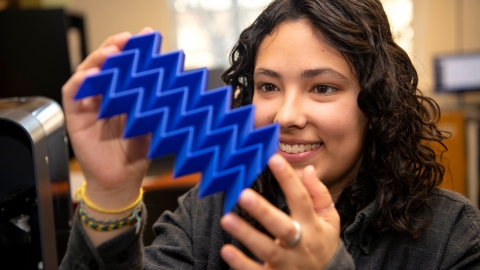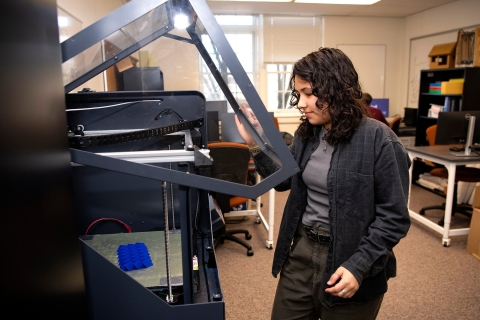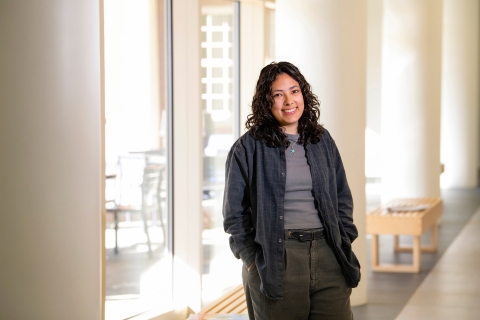
Iona Pitkin '25, Civil Engineering
October 5, 2023
As a rising sophomore, Pitkin became the newest researcher on a project that aims to use origami in engineering. Photo by Emily Paine, Communications
I didn't want to be just a STEM student; I wanted to think about humans and our connections, and I wanted an engineering curriculum that took that into account.
Before she'd even taken her first college class, Iona Pitkin '25 got a crash course in what it means to be a Bucknell engineer.
Pitkin participated in Bucknell's Engineering EXCELerator, a program designed for incoming engineering students who wish to develop their foundational skills — especially those who may have had limited opportunities prior to coming to campus. "I learned a lot about different fabrication tools, how to 3D print and use a laser cutter," Pitkin says. "So I went into my first semester knowing the basics and could just dive in."
It wasn't long before she put those skills to work. As a rising sophomore, Pitkin became the newest researcher on a project that aims to use origami in engineering. "Origami takes something fairly weak and makes it stronger," Pitkin says. "That's something we can learn from and take advantage of in engineering."

Pitkin used top-of-the-line equipment in Bucknell's Dana Engineering Labs to perform stress tests on the origami-inspired material. Photo by Emily Paine, Communications
Stress Tests
The first phase of the study involved designing 3D-printed plastic forms inspired by the rigid Miura-ori fold — a repeated zig-zag pattern of "mountains" and "valleys." Pitkin was then tasked with developing methods for testing the material.
To get a basic understanding of its behavior, Pitkin relied on experiments regularly performed in structural engineering. Using an Instron Universal Testing Machine, she spent weeks pulling and crushing the plastic specimens until they broke, then recorded their breaking points, how fast they warped and how much they splintered.
While gathering the data was relatively simple, Pitkin says, analyzing the results is significantly more challenging. "We have specimens of varying sizes, thicknesses and fold angles, so there are many data points to compare. What we're looking for is consistency."
So far, Pitkin has found that many of the specimens have similar deformation patterns and maximum load weight, while others behave differently when stressed. Her ultimate goal is to create a computational model using computer software, which requires finding numerous ways to gather and analyze data. The key question, Pitkin says, is whether the forms are buckling or crushing in on themselves; "That will decide how we can think about applying this material."

"I want to do something where I feel like I'm helping. That's the part of engineering that fascinates me. I'm always thinking about the people," Pitkin says.
Prioritizing People
Although she's wanted to be an engineer since she was little and intends to declare her major in civil engineering, Pitkin has always gravitated toward the humanities. "I love reading, history and political theory," she says. "So I didn't want to be just a STEM student; I wanted to think about humans and our connections, and I wanted an engineering curriculum that took that into account."
During her first year, Pitkin took a course on the history of protest art while living in the Social Justice Residence College, and has recently taken an interest in women's & gender studies.
Although she's still considering her post-graduate options, Pitkin wonders how she might use the knowledge gained from her liberal arts education into a career in infrastructure repair.
"I want to do something where I feel like I'm helping," she says. "Infrastructure is a big deal, and I've experienced a lot of broken infrastructure growing up in the Los Angeles area. Our cities need repair.
"It's something that can bring change to struggling communities. You can't build the community up if they don't have running water, if they don't have spaces to meet and organize. That's the part of engineering that fascinates me. I'm always thinking about the people."

